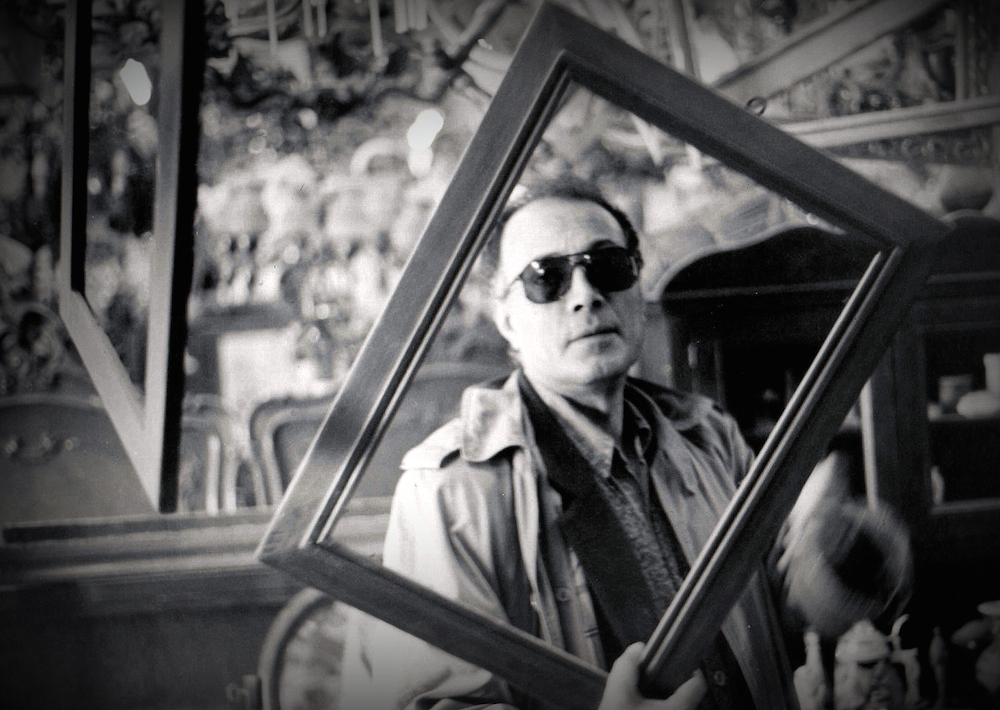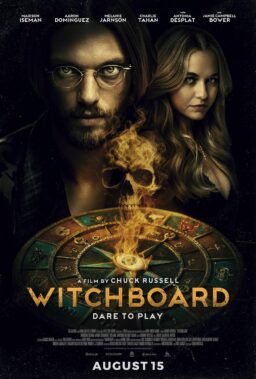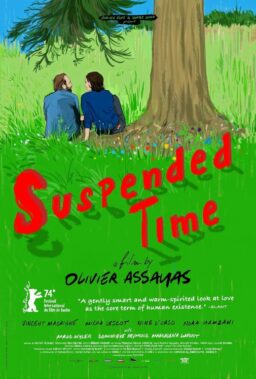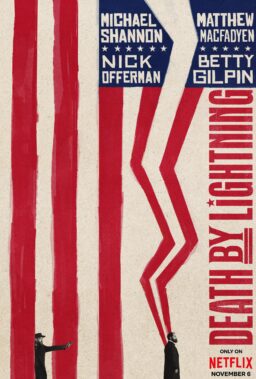With the recent passing of Iranian filmmaker Abbas Kiarostami, we asked our contributors to share a few words about the master and what his movies meant to them. Along with the submissions below, Patrick Z. McGavin’s obituary for Kiarostami can be read here, and a piece by Godfrey Cheshire about knowing Kiarostami as a friend can be read here.
SIMON ABRAMS:
I took Abbas Kiarostami’s films for granted. There was never a point where that wasn’t true. There was always time enough to explore other filmmakers, and therefore time enough to get back to him. Major advocates of the Iranian New Wave, like Godfrey Cheshire and Jonathan Rosenbaum, enabled my apathy. Sort of. These guys had covered Kiarostami’s films so well—or maybe divined a bottomless well of cultural analysis. Lesser writers like myself may contribute a little here and there with our observations about the complex mise en scène in “Like Someone in Love,” or the radical, extraordinary use of long takes in “Taste of Cherry.” But those relatively minor observations are nothing compared to the fount of knowledge that Cheshire and Rosenbaum have given us. I was fairly intimidated by Kiarostami for this reason. The erudite criticism he inspired is proportionate to his work’s intellectual and formal challenges.
At least, that’s what I told myself. I once wrote a primer on Kiarostami’s work for Wide Screen, an online weekly film periodical edited by Glenn Kenny. That piece forced me to get over my callow fearfulness, and see how playful, accessible, and even emotionally rewarding Kiarostami’s work is. I fell in love with “Taste of Cherry” again, was reminded of how much I enjoyed Kiarostami’s contribution to omnibus film “Tickets,” and watched “Certified Copy” in outright awe. Nothing substantial changed because of my writing that Wide Screen article, not really. But learning to love Kiarostami’s films taught me to get out of my own way, and stop thinking of certain films as cultural brussels sprouts.

STEVEN ERICKSON:
“Through the Olive Trees” was my introduction to Kiarostami. I had read Godfrey Cheshire and Jonathan Rosenbaum’s praise for Iranian cinema—Cheshire’s 1992 Film Comment piece on the Film Society of Lincoln Center’s Iranian retrospective was a touchstone, in retrospective, although I was foolish enough to skip the actual series and the New York Film Festival’s screening of “And Life Goes On” that year. Miramax “released” it with no advertising for a week in February 1995 in New York. I saw it with one extended Iranian family and about five other Westerners. Its combination of brains and simplicity blew me away. I soon tracked down a bootleg tape of “Close-Up,” which only deepened my curiosity about Kiarostami and Iranian cinema in general. I can’t remember if Cheshire or Rosenbaum wrote this, but one of them said “Iranian cinema went straight from the medieval to the postmodern without stopping in between.” “Taste of Cherry” would be America’s real introduction to Kiarostami—he had the Palme D’Or for protection—and I remember how reluctant critics like David Denby and even Roger Ebert were to rise to its challenges, particularly the reflexive ending. Its American release happened to coincide with a period of serious depression in my life, and during that dark spell, I spent weeks rewriting a review of “Taste of Cherry” that was eventually published in Film Quarterly. By the time Kiarostami made his late masterpiece “Certified Copy” [pictured above] he had been around long enough and had enough films released in the U.S. that critics accepted his challenges, for the most part. “Close-Up” had gone from bootleg availability to the Criterion Collection. “Certified Copy” was even a modest commercial success. I wonder where he would’ve gone if he’d had a few more years to live—reportedly, he was planning to make a film in China.

TINA HASSANNIA:
You could say I’m more of a Kiarostamiphile than a cinephile. It’s not even that I put Kiarostami’s films above others; when I’m watching a Kiarostami film it is a wholly different, more spiritual experience than watching any other film. It was always like this. I knew I had stumbled onto something extraordinary when I first saw the Koker trilogy and “Close-Up” [pictured above]. At first, I couldn’t quite even comprehend the sheer magnitude of those films’ brilliance, because I was a young cinephile who didn’t know any better, and because his films require multiple viewings. It was also easier to focus on my cultural bond with them. My connection to my homeland has been all but severed for decades, through a consistent refusal to engage with it by my own foolishness, as well as the overprotective hand of my family. In some ways, my experience mirrored those of non-Iranians, seeing Iran as if for the first time. But I can understand the micro-nuances of each line of dialogue, each hidden reference to Persian history, and they kindled something inside of me.
For me, Kiarostami’s films provided a gateway to many things: understanding and appreciating my culture, watching more Iranian cinema, and learning to appreciate aesthetic audacity. It’s almost too easy to document his experimentation—in films like “Shirin” and “Ten” and “Certified Copy,” among so many others—but it’s an understatement to call him an innovator because he was experimenting with film from the very first short film he made for Kanoon, “Bread and Alley.” Kiarostami’s films are easy to watch because they’re visually resplendent; they’re challenging to watch because they seem to contain a hidden puzzle. But the more familiar you become with his work, the less you’re sure those puzzles are meant to be solved. They’re not. They’re meant to be explored. If the ending of “Where is the Friend’s Home?” is any indication, Kiarostami believed in the experiential; to use a cliche, he preferred the journey to the destination. He revelled in the digressions of life, and thanks to the temporal features of cinema he was able to serenely express that vision.
The history of film has never encountered a director more talented at imbuing so much beauty, philosophy, poetry and humour into their work. Kiarostami is irreplaceable, a one-of-a-kind artist who defied the geographical boundaries of his country and the formal limitations of cinema to touch millions of viewers around the world. He had more art in him, and I’m sad we may never get to see it. For those who are just beginning to discover Kiarostami, may I recommend that you start … anywhere, but please, don’t ever stop watching his films. Even his early work from the 1970s and 1980s—those rare shorts, features and documentaries you can find on Criterion supplements or through retrospectives—deserve attention, and I hope they will all get their proper release one day.

MICHAŁ OLESZCZYK:
My first exposure to Kiarostami came about in 1997, when Polish public TV channel aired “Through the Olive Trees” on a (very) late Sunday night. I was a cinephile by then, and I remember being entraced by the unobtrusive way Kiarostami merged a budding small-village love story and a subtly comic reflection with the moviemaking process. I rewatched the final long shot of the film several times, variously imagining the distant meeting of the boy and the girl to be a loving reunion or a brusque break-up. I have been following Kiarostami’s career ever since, staying pleasantly hungry for the sense of refreshment each of his projects brought. As the years went by, more and more folks got into the whole “death of cinema” mystique, and yet there was Kiarostami as the supreme rebuttal: using cinema’s most simple resources (framing, staging, time, image, sound) to renew its aesthetic every single time. “Ten” [pictured above] and “Taste of Cherry” are perhaps my favorite movies of his, each discovering the boundless potential of that most simple of devices: splicing a filmed conversation together so that we’re tricked into a sense of characters’ presence.
When I think of Kiarostami, I tend to think of driving: a skill I never mastered myself, except insofar as being a perfect companion and passenger. Kiarostami’s faces are forever forward-looking, a bit absent-minded, relieved from other person’s gaze the way passengers are on a long, long drive. He was a supreme director of shared loneliness, even in his glossier fare, such as the overpraised “Certified Copy,” in which he started to dangerously flirt with fancy. He will be just as missed as every single master of cinema we have lost in this cruel, cruel year.

SHEILA O’MALLEY:
I took a friend to see “Certified Copy” when it played at the Film Forum. I had already seen it at the New York Film Festival, and reviewed it for Capital New York: the experience of that film made me dizzy. I emerged from the theatre actually light-headed. Months later, it opened in a limited release and I knew my friend would respond to it, so I took her. She was not familiar with Kiarostami. She went in with no preconceived notions about it or him. Afterwards, we walked to get some dinner, and instead of talking about the movie we started talking about our respective significant-others. My friend, out of nowhere, stopped in her tracks and, spontaneously, like a flood, burst into tears. New York passersby skirted around us, looking away from our mini-sidewalk-scene. I hovered near my friend, waiting to hear what painful thing she might have been about to share, but instead she sobbed, through her hands, “That movie … that movie … that movie …” I thought to myself later, “Yes. That’s Kiarostami for you.”
“Taste of Cherry” was the first Kiarostami film I saw, and its hypnotic rhythm, dusty brown palette, and from-the-vehicle perspective (not to mention the ending), captivated me, nagged at me, moved me. I knew I had seen something unique, and how often can you say that about any movie? I backtracked and saw as many of his films as I could, as well as all current releases when they hit our shores. “Certified Copy.” The magnificent “Like Someone In Love”. “Where Is the Friend’s Home?”, “Through the Olive Trees,” “Five Dedicated to Ozu”, “The Wind Will Carry Us” (I love Kiarostami’s titles). I went through a good four-month period where I was so obsessed with “Shirin” [pictured above] that I watched it over and over again. I couldn’t (and still can’t) get to the bottom of that movie, part of its enduring fascination.
But it was “Close-Up” that knocked me flat. It took me days to get my bearings afterwards. What Kiarostami did in “Close-Up” made me actually re-think cinema itself, in a way I’ve rarely felt or experienced. It reminded me of how I felt when I first encountered Godard’s films in college. He made all other directors look like they were playing it safe, or following a preconceived structure without question. Like Godard’s most challenging works, “Close-Up” plays by its own rules. “Close-Up” questions the very concept of rules. Who says what a movie is supposed to be, what is supposed to provide, how it is supposed to operate? Over his entire career (as a writer and director), Kiarostami has been the ultimate individualist. Who could conceive of something like “Shirin,” and then get such results from it! Kiarostami has led the way in personal experimentation, intellectual rigor and emotional complexity, and yet so few artists can follow in his footsteps since he, like all geniuses, is sui generis. He will continue to inspire for generations to come.

MATT ZOLLER SEITZ:
My first Abbas Kiarostami film was “Close-Up.” I saw it at the urging of RogerEbert.com contributor Godfrey Cheshire, who was then my editor at New York Press. Godfrey did more to introduce Iranian cinema to the American critical mainstream in New York than anybody. He was a particular champion of this film, and knew its complicated production history as well as most Americans know the details of the first “Star Wars.” He wrote a piece about it, one of the longest pieces of criticism ever published in our newspaper, solely about this film. I mention all this to give you a sense of what a buildup this film had before I saw it. I’d seen other Iranian movies, mainly from the ’90s, but for some reason this was my first Kiarostami.
It did not disappoint. At all. I had never seen a, basically, legal thriller about something so mundane as an impersonation case, in any language, and the fact that it was half straightforward documentary, part re-enactment with all the roles played by the actual participants, added a second, even more striking layer to the experience. I’d never seen a film with of such deadpan humor that was also compassionate and mysterious. A hovering unknowingness, a respect for not knowing, a humble willingness to think about what it means to accept not knowing, suffused the entire film. Every single piece of the work seemed to fit with every other. Those who have seen it more than once will tell you that it’s one of those films that grows richer with repeating viewings, to study the performances, the structure, the shots, the cuts, every aspect of cinema that Kiarostami and his collaborators had mastered.
From there I went on to see every Kiarostami film I could. I have experienced this kind of elation for art a few times in my life, and this was one of them. It was as if a flower had exploded in my mind and I was chasing the petals. Whenever I see a new movie that tries to balance formal ambition against the most basic dramatic satisfactions, I think of “Close-Up.”

PETER SOBCZYNSKI:
I do not see any way in which I can possibly sum up the life and career of the late Abbas Kiarostami in a mere paragraph or two. This is kind of fitting, in a way, because he was not the kind of filmmaker whose works lent themselves to easy explanations and interpretations. What I can say is that when I saw my first film by him, the Palme d’Or winner “Taste of Cherry” [pictured above], I was more or less blown away. Although seemingly straightforward on the surface, this film about a man driving around searching for someone who will help him commit suicide proved to be an utterly original and fascinatingly complex meditation on the fragility of life and the finality of death. It was both narratively direct, deeply philosophical and more spiritual in tone than most overtly religious films; “Taste of Cherry” was also incredibly deft in the way that it blended elements of dramatic and documentary filmmaking styles. While I am not certain that I can fully explain everything about it (such as the controversial final images that I shall not mention in case his passing inspires you to look it up), I knew even then that this was a film one could return to over the years—that it would not only continue to be fascinating on its own, it would go on to mean different things to viewers, depending on where they were in their lives when watching or rewatching it. This was the work of a true original, and while it would prove to be my favorite of the films of his that I have been able to see over the years, I don’t think that he ever made a movie that played it safe—even when he began moving towards a more international approach by filming outside of Iran or employing familiar faces like Juliette Binoche, he continued to make films solely on his own terms without any concessions to the marketplace. With his passing, the world of cinema has lost one of its most distinct and humane voices and it is the worse for it.

PABLO VILLAÇA:
The first time I wrote about a Kiarostami film, I was 23. It was May of 1998, “Taste of Cherry” [pictured above] had just been released in Brazil and my website was just seven months old. And there I was, trying to write about a movie that had touched me while struggling with my own immaturity to express it. Rereading that piece almost 20 years later, I can only marvel with Kiarostami’s ability to move a young man across the world in such a way that, even without being able to understand my internal process, I could still realize I had seen something special. In the years that followed, I had the opportunity to discover the filmmaker’s past works and to witness how he continued to grow as a storyteller and as a human being—and when I wrote about “Certified Copy” and “Like Someone in Love,” I finally felt I was beginning to grasp not only the reach of his humanity but also his impeccable formal control over every element of the narrative: the way he used the off-screen space (all of the six pointed out by Noël Burch; as in “Through the Olive Trees” and “Taste of Cherry”), the careful composition of his shots, the brilliant use of metalanguage, the minimalistic performances of his casts and the sound design that filled the atmosphere of the universes he created. Kiarostami delved into the anguishes of his characters and enchanted us by reflecting our own.
Click here to read Patrick Z. McGavin’s obituary for Kiarostami
Click here to read Godfrey Cheshire’s reflections on his friendship with Kiarostami











